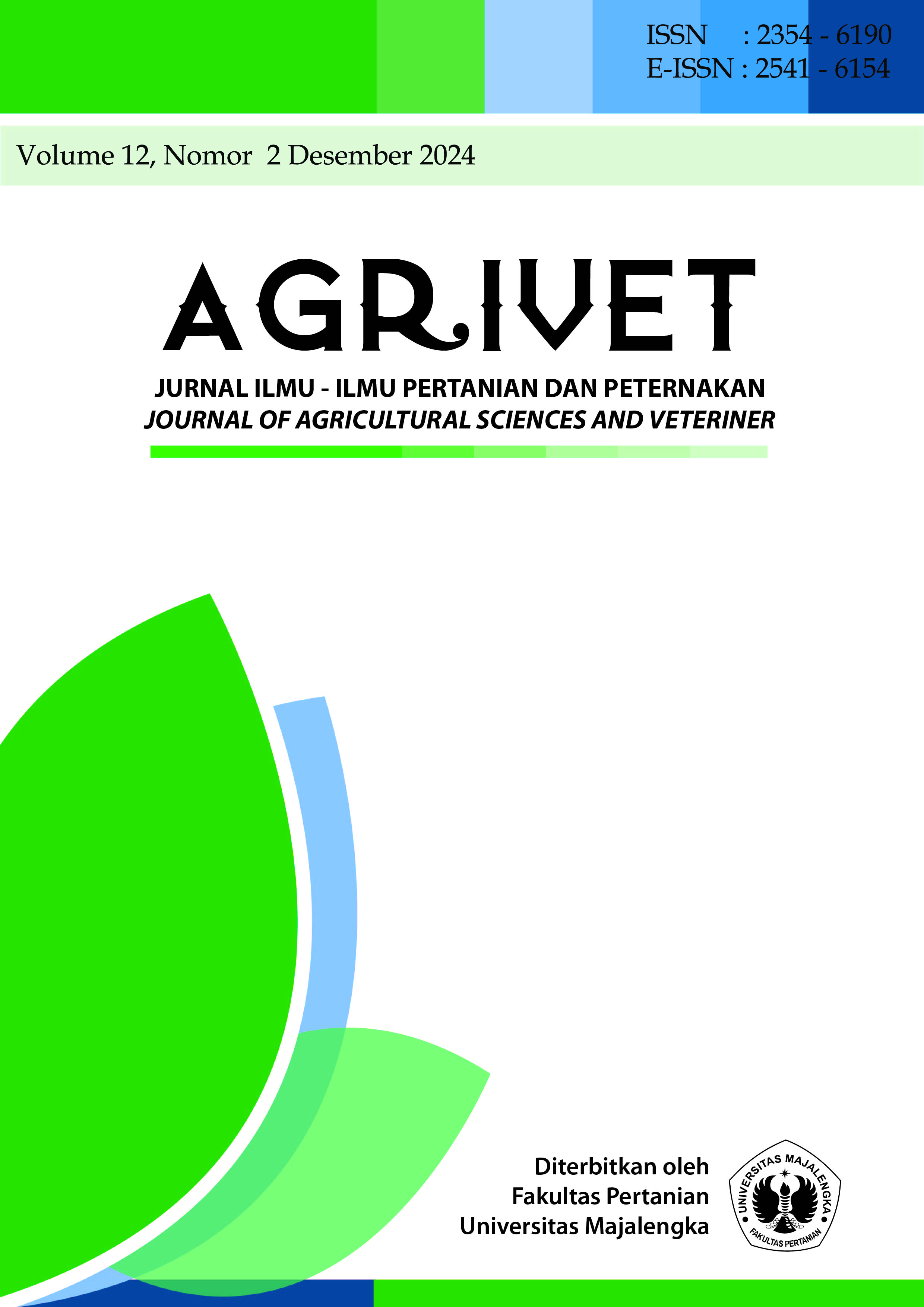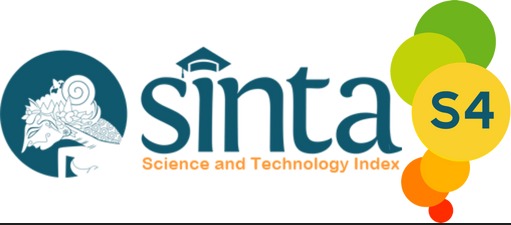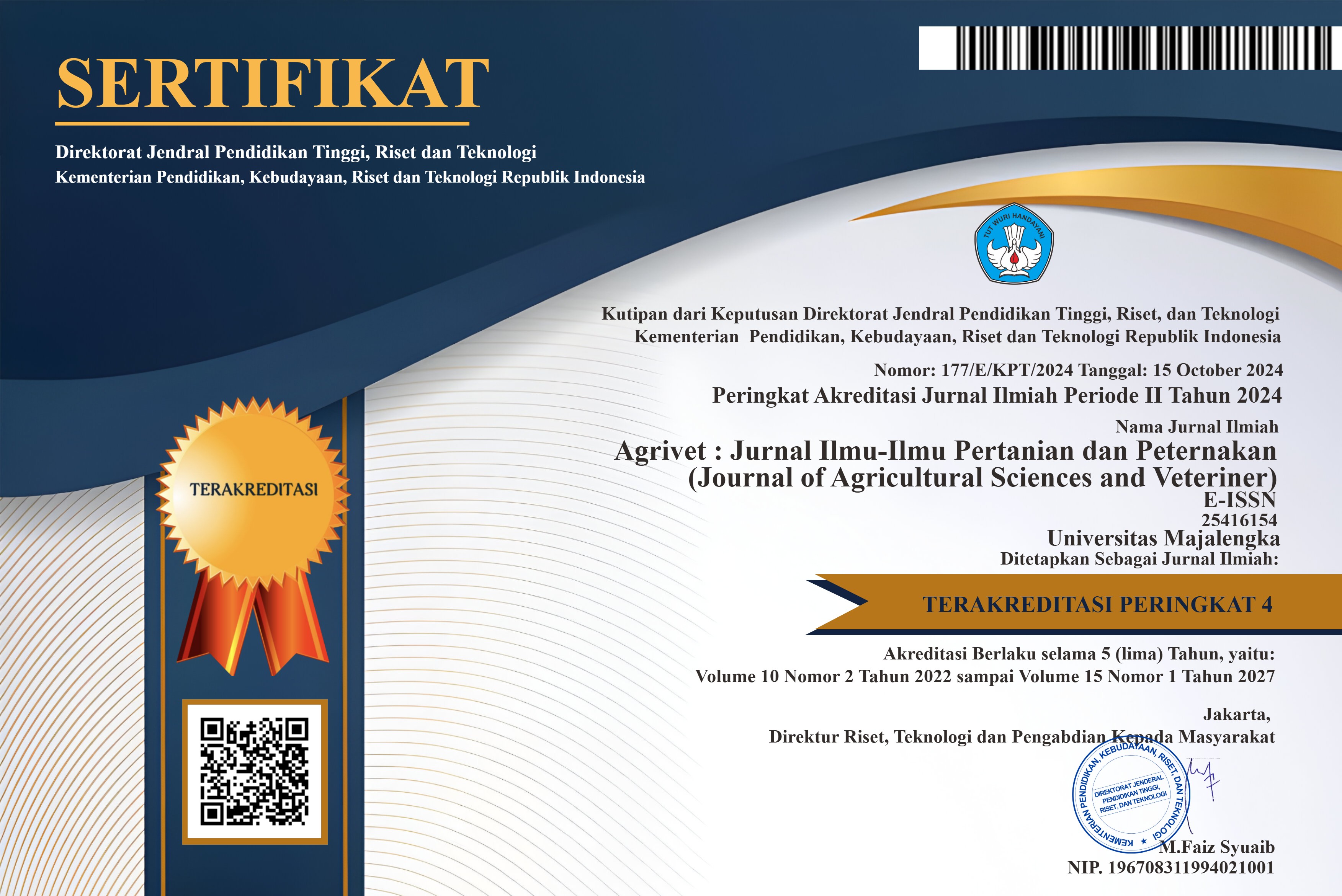Kadar gula reduksi, protein kasar, dan bahan organik biokonversi kotoran ayam petelur menggunakan kapang Aspergillus niger dan Trichoderma viride sebagai bahan pakan alternatif
DOI:
https://doi.org/10.31949/agrivet.v12i2.10478Abstract
Layer manure is generally only used as organic fertilizer, whereas it has the potential as animal feed through bioconversion using Aspergillus niger and Trichoderma viride fungi. The study aims to determine the levels of reducing sugar, crude protein, and organic matter from layer manure resulting from bioconversion with Aspergillus niger and Trichoderma viride. The study used a completely randomized design (CRD) of 4 treatments and four replications. The treatments given were manure inoculated (3% DM) with A: Trichoderma viride (6 days incubation); B Aspergillus niger (6 days incubation); C. Trichoderma viride (3 days incubation) followed by Aspergillus niger (3 days incubation); D. Aspergillus niger (3 days incubation) followed by Trichoderma viride (3 days incubation). The results showed that inoculation of Aspergillus niger and Trichoderma viride in manure bioconversion had a very significant effect (P<0.01) on the levels of reducing sugar, crude protein, and organic matter. The highest levels of reducing sugar were produced in treatment B with Aspergillus niger inoculation. The highest levels of crude protein were produced in treatment A with Trichoderma viride inoculation, and the highest organic matter content was produced through inoculation of a combination of both types of molds. It can be concluded that the manure bioconversion inoculated with Aspergillus niger and Trichoderma viride produced varying levels of reducing sugar, crude protein, and organic matter.
Keywords:
Aspergillus niger, fermentation, layer, Trichoderma viride, Close houseDownloads
References
Layer manure is generally only used as organic fertilizer, whereas it has the potential as animal feed through bioconversion using Aspergillus niger and Trichoderma viride fungi. The study aims to determine the levels of reducing sugar, crude protein, and organic matter from layer manure resulting from bioconversion with Aspergillus niger and Trichoderma viride. The study used a completely randomized design (CRD) of 4 treatments and four replications. The treatments given were manure inoculated (3% DM) with A: Trichoderma viride (6 days incubation); B Aspergillus niger (6 days incubation); C. Trichoderma viride (3 days incubation) followed by Aspergillus niger (3 days incubation); D. Aspergillus niger (3 days incubation) followed by Trichoderma viride (3 days incubation). The results showed that inoculation of Aspergillus niger and Trichoderma viride in manure bioconversion had a very significant effect (P<0.01) on the levels of reducing sugar, crude protein, and organic matter. The highest levels of reducing sugar were produced in treatment B with Aspergillus niger inoculation. The highest levels of crude protein were produced in treatment A with Trichoderma viride inoculation, and the highest organic matter content was produced through inoculation of a combination of both types of molds. It can be concluded that the manure bioconversion inoculated with Aspergillus niger and Trichoderma viride produced varying levels of reducing sugar, crude protein, and organic matter.
Published
How to Cite
Issue
Section
License
Copyright (c) 2024 Nadia Padli, Eva Yulia, Ramaiyulis

This work is licensed under a Creative Commons Attribution-ShareAlike 4.0 International License.
An author who publishes in the Jurnal Agrivet agrees to the following terms:
- Author retains the copyright and grants the journal the right of first publication of the work simultaneously licensed under the Creative Commons Attribution-ShareAlike 4.0 License that allows others to share the work with an acknowledgment of the work's authorship and initial publication in this journal
- The author is able to enter into separate, additional contractual arrangements for the non-exclusive distribution of the journal's published version of the work (e.g., post it to an institutional repository or publish it in a book) with the acknowledgment of its initial publication in this journal.
- The author is permitted and encouraged to post his/her work online (e.g., in institutional repositories or on their website) prior to and during the submission process, as it can lead to productive exchanges, as well as earlier and greater citation of the published work












